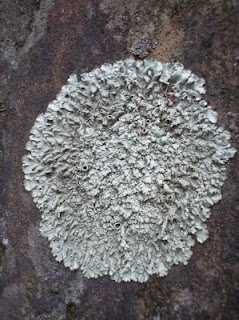Lichens
Whilst visiting the forest, we came across trees and logs
containing lichens. We wondered what they were and wanted to find out a little
more about them. After doing some research, I found out the following:
There are around 25000 species of lichens. Lichens are named
according to the species of fungus involved. Lichens are found in many parts of
the world, even polar regions and high altitudes. They can grow on rocks, wood or firm soil.
They grow very slowly and most are a grey-green colour. However, they can also
be white, yellow, yellow-green, red, orange, brown or black (2). Lichens are
formed by a fungal partner (mycobiont) and an algal partner (phycobiont) (1). The
fungi and the algae have a symbiotic relationship. It has been found that the
algae makes food for the lichen through photosynthesis and the fungi provides
protection for the algae and obtains water and minerals for the lichen. When algal
and fungal cells combine, they form a structure known as a thallus. The thallus
is the visible body of the lichen. In many lichens, the algal and fungal cells
inside the thallus produce chemical compounds that neither the algae of fungi
can produce independently (2). The shape of the thallus is used by scientists to
classify lichens into three main types:
· Crustose Lichens
(e.g. brown crust lichen. They are crust like and can attach to rocks) (2)
· Foliose Lichens
(e.g. dog-tooth lichen. They are flat and have leaf-like structures) (2)
· Fruticose Lichens (e.g.
reindeer moss. They have erect or hanging branch-like structures) (2)
Lichens and the nitrogen cycle
Lichens contribute to the nitrogen cycle as they convert
nitrogen in the air into nitrates which contribute to their growth and development.
Their contribution to the nitrogen cycle is also beneficial to plants because
when it rains, nitrogen leaks from living and dead lichens and is available to
plant life in areas around it. When lichens die, they give decayed organic
matter to the area in which they inhabited, enabling mosses and seeds from
vascular plants develop in the new soil (3).
Lichens turn nitrogen in the air (N2) into nitrates (NO3-)
Reproduction of lichens
Lichens can reproduce both sexually and asexually. They can
develop sexually by producing spores which develop into fungi. Wind/rain
transports algae to this fungi to produce a lichen (2). Lichens reproduce
asexually in two ways: by producing soredia (a cluster of algal cells wrapped
in fungal filaments) which then disperse to form new lichens, or by producing isidia
(like soredia but they are enclosed within a layer of protective cortex tissue).
Isidia break off and colonise new areas (4).
Lichen grow in many conditions
Most lichens are temperate or arctic. They tend to grow
better in drier environments. Their secret of success is not fully understood,
however their ability to survive drying and their complex chemistry are
important aspects (4) (the chemistry of the lichen pigments is complex. It
involves a diversity of oxygen ring compounds, called ‘lichen acids’) (7). Lichens
can survive a complete loss of body water. When moisture becomes available
again, they quickly absorb this water, becoming soft and fleshy again. Whilst
they are dry and brittle, pieces may flake off, which may then later grow into
new lichens (4).
How do lichens feed?
Lichens do not have roots, stems, flowers or leaves. However,
the algae photosynthesise. They can photosynthesise when the temperature is
well below freezing (5). The algae photosynthesise like plants, however
different mechanisms are used. In algae photosynthesis, chlorophyll is not
always the primary pigment. A wide variety of accessory pigments may be used in
algae to photosynthesise, which is why algae are found in so many different
colours (6).
Economic benefits of lichens
Lichens have been a source of natural dyes for wool and
fabric for many years. To make lichen dyes, you can boil them in water for
several hours. The pH may be altered by adding vinegar or washing soda to get
the desired colour. Lichen dye can also be produced by slow fermentation of the
lichen in aqueous ammonia for a couple of weeks (7).
Some lichens have antibiotic properties. Europe uses the genus Usnea in ointments and other commercial products. It is said to aid healing in wounds (3).
Lichens have been used in deodorants, laxatives, tonics, and healing pastes. Research has begun to show that lichens may be able to be used to fight against some cancers and viral infections, such as HIV (3).
Some lichens have antibiotic properties. Europe uses the genus Usnea in ointments and other commercial products. It is said to aid healing in wounds (3).
Lichens have been used in deodorants, laxatives, tonics, and healing pastes. Research has begun to show that lichens may be able to be used to fight against some cancers and viral infections, such as HIV (3).
Lichens growing on trees
In the northern hemisphere, lichens tend to grow on the
north side of the tree. Because direct sunlight does not hit the north side of
the tree, the bark there hardly dries out, creating a good environment for
lichens to grow. Lichens usually grow around the entire tree. However, there
tends to be a more dense area of lichens on the north side of the tree, as
there is more moisture there (8).
Why do lichens grow on logs?
Logs do not contain any leaves, therefore there is no
competition for lichens to get sunlight. The log also provides the lichens with
moisture. Therefore, the sunlight and moisture availability provide good
conditions for the lichens to photosynthesise.
By Lauren Watmough







No comments:
Post a Comment